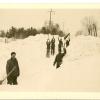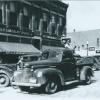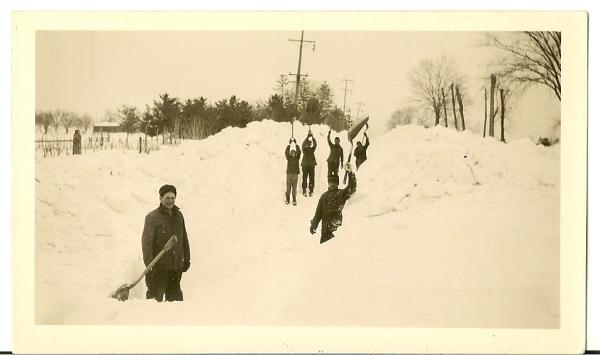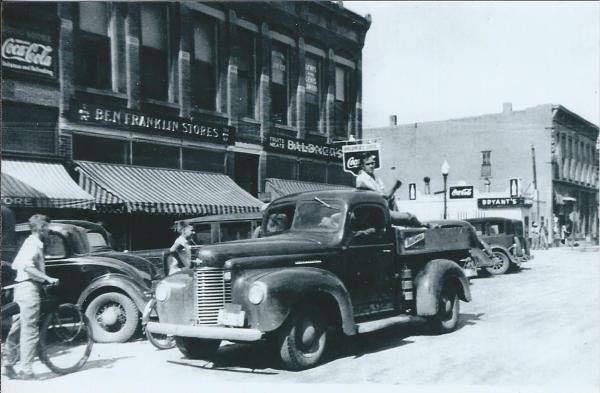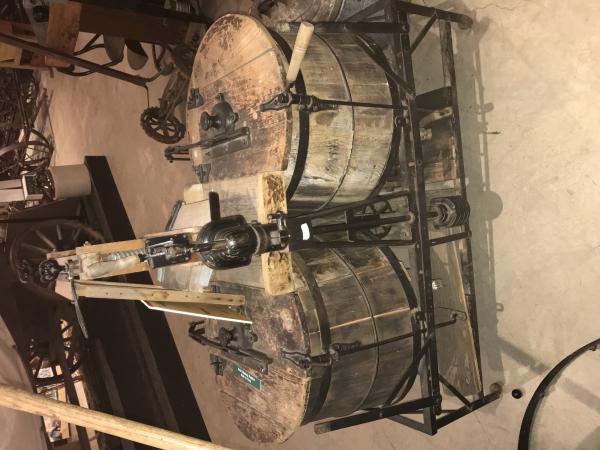Iowa and the Great Depression
| Grade | 9th -12th Grades | Class | U.S. History | Length of Lesson | 50 minutes |
| Lesson Title | Iowa and the Great Depression |
| Unit Title | The Great Depression |
| Unit Compelling Question | Does a government provide assistance during a time of need? |
| Historical Context: 2018.059.005 The winter of 1936 was one that went down in Iowa's history books. During the winter of 1936 a series of blizzards struck Iowa. It caused towns to completely shut down. Trains were halted for days at stations, schools were closed, and people couldn't get into towns. Groups of citizens like the ones pictured in this photograph, took upon themselves to form groups to shovel snow off country roads in order to get to town. 2018.021.071 This photograph shows the north side of the Mount Ayr town square in the mid-1940s. The truck in the middle of the street is a Mount Ayr Mill & Feed delivery truck. Three different Coca-Cola signs can also be seen in the photo. Started by Tennant and Anderson, the Mount Ayr Mill and Feed specialized in two types of milling. The first was table-use milling, which provided cornmeal, buckwheat flour and cracked wheat for breakfast foods that would later be sold at surrounding local grocery stores. The second type was to produce animal feed which was made with a hammer mill or feed mixer. These were collected into stamped or printed sacks for sale. Despite low sales during the Depression years, the company was able to stay open and continue their business. In 1937, Tennant and Anderson partnered with Nutrena Feed and continued to work six days a week with a total of only five employees. 2018.044.005 The Globe Manufacturing Company created on January 21, 1907 in Perry, Iowa. The President was J.C. Bryan. This company produced state of the art washing machines. The company itself was very popular and grew in high demand. Globe Manufacturing was in fact so large that it had to move to a larger building. The company also had storage buildings in major Midwestern cities. The plant caught fire on January 27, 1915, but was rebuilt. There were sixty workmen and twenty five salesmen, as well as office workers who worked in the plant. Minimum wage was 35 cents. The washing machine shown is a "Quicker Yet" Washing Machine designed by Mr. Kibby, director and active manager of Globe Manufacturing Company. This machine was very popular and very advanced for its time. Unfortunately, the plant had to close its doors in the 1930s due to a number of reasons, including the Great Depression and competition. (Hastie, 1970) ### While things got much worse for many in the United States in the early 1930s, the years of the Great Depression, Iowa farmers and those who depended on them saw tough economic times through the 1920s. During WWI, the government urged farmers to grow more crops and livestock. It guaranteed high prices and encouraged farmers to invest in new machinery and equipment to boost their production. Rural banks loaned farmers money, and the value of farmland boomed. With the war's end, the government announced suddenly that it would no longer guaranteed wartime prices, but farmers were already geared up to produce more. Europe had been buying record amounts of U.S. agricultural goods, but as their own farms got under production again, sales to Europe dropped. Farmers were producing more than the market needed, surpluses developed, crop prices plummeted and the land boom was over. Many banks in Iowa went into bankruptcy during the early 1920s when farmers couldn't repay their loans. In the 1920s, nearly half of all Americans lived on farms or in small towns. When agriculture suffered, rural Americans could no longer buy the products produced in urban factories, and factories began to close, further cutting down on Americans' purchasing power. The stock market, which had seen record gains throughout the 1920s, took a sudden downturn in the fall of 1929, and a rapid downward economic slide created a dangerous situation. Herbert Hoover was president, and many people blamed him for not doing more to bolster the economy. There was a near-desperate situation in rural Iowa. Record numbers of farms were sold on auction to pay taxes or debts, and farm families were losing their homes. Some radical groups of farmers threatened violence to those responsible for enforcing the laws. A judge in LeMars was pulled from the bench, taken into the country, and threatened with a lynching if he didn't promise to stop farm sales. Fortunately, the mob disbanded without doing him further violence. Some farm groups tried to stop local farmers from taking their milk, butter, and eggs to market in order to raise prices, but the efforts had little impact. In 1932, Iowans broke with their Republican tradition and voted for Democrat Franklin D. Roosevelt for President. Roosevelt appointed Iowan Henry A. Wallace to be Secretary of Agriculture. Wallace drafted a bill that promised farmers a guaranteed price for their crops and livestock if they would limit their production. It was the Agriculture Adjustment Act. Since surpluses were depressing prices, the bill's goal was to reduce the surplus and let the market restore higher prices. While its impact on prices is under debate, the bill did pump much needed cash into rural economies and provided enough support to help farmers weather those very tough years. The weather also contributed its own help in reducing crops. Severe droughts with record heat severely cut Midwestern yields in the summers of 1934 and 1936. While their incomes were low, farm families could still produce much of their own food in home gardens, livestock, and flocks of chickens. Urban families also suffered and usually lacked the food sources of the farm. Iowa factories in manufacturing towns like Waterloo, Dubuque, Davenport, Cedar Rapids, and Des Moines shut down throwing employees out of work. At the time, going on welfare was seen as a disgrace, even when one had no responsibility for the for the loss of work. It took a psychological blow on self-esteem when a worker had to apply for government assistance and many resisted as long as they could. It seemed to be an admission of failure. The Depression had a lasting impact on those who lived through it. Sometimes children were unaware of how it strained their parents' resources. The children recall that they "didn't know we were poor because everyone was poor." But adults knew. Jobs were hard to get. Young men who couldn't find jobs sometimes took to riding railroad cars from town to town in search of a means of support. The government offered several work programs. The WPA (Works Progress Administration) hired men (and some women) to do public service jobs. The Civilian Conservation Corps recruited teenage boys to build parks, restore eroded lands, plant trees and other outdoor projects. The 1930s saw hard times for many American families. When WWII began, suddenly there was a demand for guns, tanks, uniforms, and everything else necessary to fight a war, the men and women to staff the army, and the food to feed them. Young men who couldn't find work before were drafted into military service. Women picked up jobs on the home front with active encouragement by the Federal government. The Great Depression was only the lowest point in the two decades between WWI and WWII. It made a lasting impression on those who lived through it. |
|
| Lesson Supporting Question | |
| Lesson Overview | Following the stock market crash of 1929, the American economy was in a large recession. This lesson brings the economic struggle of the nation home to Iowa. Students will look at how the depression has affected our state and connect it to how it affected the nation as a whole. Students will be able to understand the roles of Iowans and how they reacted to the Great Depression. |
| Primary Sources Used |
|
| Resources Needed | |
| Standard | |
| Lesson Target | Students will be able to understand the roles Iowans played in the Great Depression;Students will be able to analyze the effects of the Great Depression on rural and urban Iowa. |
| Lesson Themes | Cities, Rural Life, Towns, Weather, Communal Groups, Disaster and Crisis |
|
| Formative Assessment (How will you use the formative assessments to monitor and inform instruction?) |
At the beginning of the lesson, students will be asked to recall the information taught from previous lessons. This will allow the instructor to correct and misconceptions before beginning the new material. Students will do a think-pair-share with their peers. Students will analyze an image. At the end of the lesson, students will write a two-paragraph essay on who was worse off during/following the great depression. This will be an opinion piece and they will be expected to use their class notes and prior knowledge from the unit in order to determine their answer. |
| Summative Assessment (How does the lesson connect to planned summative assessment(s)?) |
This information learned during this lesson will contribute to the final unit exam. The essay question will consist of "How did Iowans react to the Great Depression?" The material learned will allow them to create an educated response as well as determine how the effects were felt in both rural and urban areas. |
| Author | Scott Poe | Created | Last Edited | ||||
| Reviewer: Chad Christopher, History Education, University of Northern Iowa | |||||||
| Lesson Plan Development Notes: Teaching Methods, University of Northern Iowa, Spring 2019 | |||||||

